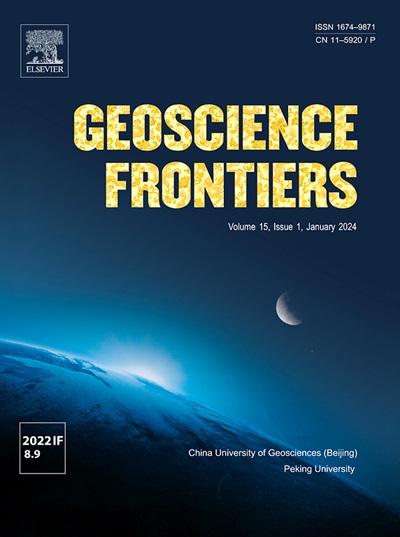南大西洋共轭边缘未知超延伸大陆地壳的古地理意义
IF 8.5
1区 地球科学
Q1 GEOSCIENCES, MULTIDISCIPLINARY
引用次数: 0
摘要
由于缺乏有关被动边缘盆地下延伸大陆地壳性质的信息,对支离破碎和分散的大陆进行古地理重建往往是一项挑战。为了确定被动边缘盆地下大陆地壳的宽度及其对共轭大陆边缘古地理重建的影响,本研究调查了南大西洋南部共轭边缘大陆地壳延伸的结构。研究区域包括南非、纳米比亚、巴西南部和乌拉圭,它们是在冈瓦纳西南部中生代断裂过程中形成的。研究采用多工具方法,结合地震解释、重力、磁力测量和 U-Pb 同位素数据,旨在量化拉伸大陆地壳的延伸及其对板块重建的影响。研究显示,恢复的拉伸地壳至少横跨 150 公里,这强调了考虑两个边缘之间的联系对于现实古地理重建的重要意义。此外,非洲西南部和南美洲东南部之间截然不同的 U-Pb 锆石年龄分布模式进一步说明,尽管它们起源于冈瓦纳山脉,但缺乏直接联系。本研究估计缺失的联系约为 150 公里,其大小与安第斯山脉或乌拉尔山脉等主要山脉相当。这项工作揭示了地球地壳动态演化的关键方面,并强调了考虑南大西洋共轭边缘地壳拉伸和侵蚀的全面重建的必要性。本文章由计算机程序翻译,如有差异,请以英文原文为准。

Paleogeographic significance of unknown hyperextended continental crust in South Atlantic conjugated margin
The paleogeographic reconstruction of fragmented and dispersed continents often poses a challenge due to the lack of information regarding the nature of that extend beneath passive margin basins. To define the width of the continental crust beneath passive margin basins and its implications for paleogeographic reconstruction of conjugate continental margins, this study investigates the architecture of the stretched continental crust of the southern South Atlantic conjugate margin. The investigated region encompasses South Africa, Namibia, southern Brazil, and Uruguay, which were formed during the Mesozoic rifting of SW Gondwana. Employing a multi-tool approach combining seismic interpretation, gravity, magnetometry, and U-Pb isotopic data, the research aims to quantify the extension of stretched continental crust and its implications for plate reconstructions. The study reveals that the restored stretched crust spans at least 150 km, emphasizing the significance of considering connections between both margins for realistic paleogeographic reconstructions. Furthermore, the distinct U-Pb zircon age distribution patterns between SW Africa and SE South America reinforce the lack of direct connections despite their Gondwanan origin. The missing link estimated in this study is around 150 km, comparable in size to major mountain ranges such as the Andean or Urals. This work sheds light on critical aspects of Earth’s dynamic crustal evolution and emphasizes the need for comprehensive reconstructions considering stretched and eroded crust in the South Atlantic conjugate margin.
求助全文
通过发布文献求助,成功后即可免费获取论文全文。
去求助
来源期刊

Geoscience frontiers
Earth and Planetary Sciences-General Earth and Planetary Sciences
CiteScore
17.80
自引率
3.40%
发文量
147
审稿时长
35 days
期刊介绍:
Geoscience Frontiers (GSF) is the Journal of China University of Geosciences (Beijing) and Peking University. It publishes peer-reviewed research articles and reviews in interdisciplinary fields of Earth and Planetary Sciences. GSF covers various research areas including petrology and geochemistry, lithospheric architecture and mantle dynamics, global tectonics, economic geology and fuel exploration, geophysics, stratigraphy and paleontology, environmental and engineering geology, astrogeology, and the nexus of resources-energy-emissions-climate under Sustainable Development Goals. The journal aims to bridge innovative, provocative, and challenging concepts and models in these fields, providing insights on correlations and evolution.
 求助内容:
求助内容: 应助结果提醒方式:
应助结果提醒方式:


